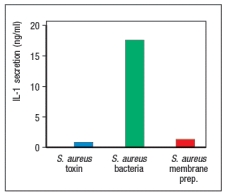Multiple Choice
Dendritic cells in the skin, known as Langerhans cells, express very high levels of the NOD-like receptor, NLRP3. Previous studies showed that treatment of these cells with the Staphylococcus aureus pore-forming toxin causes K+ efflux from the cells. To investigate whether this signal could induce IL-1 (an inflammatory cytokine) secretion by the cells, the following study was performed: 
The explanation for these results is:
A) NLRP3 is not activated by K+ efflux from the cells.
B) The S. aureus toxin does not kill the Langerhans cells.
C) The live S. aureus bacteria activate a TLR and NLRP3.
D) The S. aureus membrane prep does not contain a TLR ligand.
E) TLR activation by S. aureus membranes induces interferon production.
Correct Answer:

Verified
Correct Answer:
Verified
Q17: A key feature of TLR signaling is
Q18: When stimulated by binding to bacterial
Q19: The extravasation of neutrophils into tissues at
Q20: In recent years, several new vaccines have
Q21: Two strains of mice were infected
Q23: The first pattern recognition receptor (PRR) important
Q24: In the sea urchin, a massive diversification
Q25: Immunodeficiency diseases occur when individuals have defects
Q26: Many different viruses encode proteins that function
Q27: An infection in the skin, such as